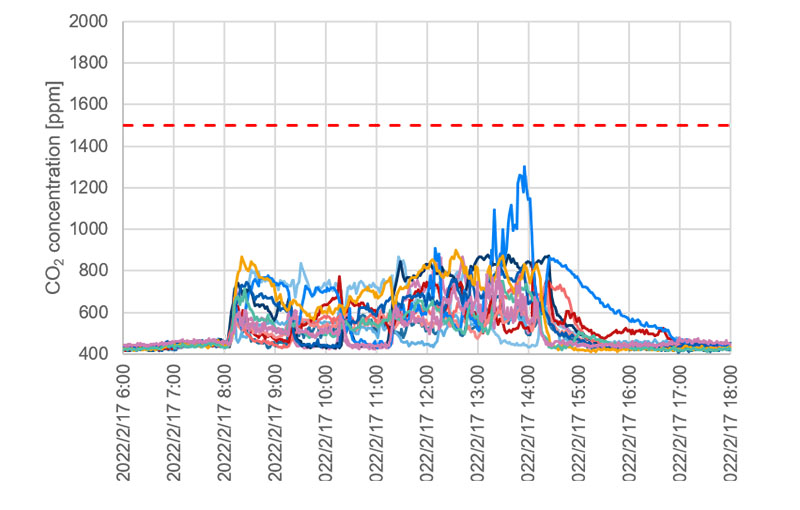Case Study: Tagoura Junior High School (Classroom)
While it is important to ventilate classrooms, other areas in schools may have dense CO2 concentrations, such as elevators, hallways, gymnasiums, broadcasting rooms, and nurses’ offices.
Even if classrooms are properly ventilated, it is not possible to provide a truly safe and secure educational environment for children if sites with dense CO2 concentrations can be found in other parts of the school. Here, we highlight some locations that are often overlooked, as found from measurements outside of the classrooms at Tagoura Junior High School.
CO2 Sensors
CO2 Concentrations in Classrooms
In reality, what are the actual CO2 concentrations in classrooms? In this demonstration project at Tagoura Junior High School, CO2 sensors were placed in all 13 classrooms to monitor CO2 concentrations on a daily basis.
The Board of Education had previously instructed the school to ventilate spaces within the school, so teachers routinely opened and closed the windows in each classroom.
Figure 1 shows the results of measurements under conditions where teachers had not been informed about the CO2 concentrations in their classrooms. Figure 2 shows conditions after the results of measurements were shared with the teachers. No new equipment other than CO2 sensors were installed, nor were rules put in place.
Despite the fact that only measurement results were shared, ventilation conditions improved dramatically, while in all classrooms, CO2 levels were well below the environmental health standard of 1500 ppm for schools. Variations between classrooms also decreased.
Simply visualizing and recognizing CO2 concentrations as numerical values has resulted in the ability to take proper action to ventilate classrooms, which has had a significant impact on improving the environment.
 Figure 1. CO2 concentration before opened windows
Figure 1. CO2 concentration before opened windows
 Figure 2. CO2 concentration after feedback
Figure 2. CO2 concentration after feedback
Feedback from Teachers
Teachers offered positive feedback on the benefits of visualizing ventilation conditions using CO2 sensors. Below are some of the actual comments from teachers.
・CO2 sensors provide a real sense of conditions because values are immediately visible.
・The measured values put us in control of ventilation and calling for windows and doors to be opened. The measured values were very persuasive because of the use of objective indicators.
・The awareness that levels were being measured helped us to recognize the need for ventilation, which has resulted in improvements to the environment in classrooms.
・In recent years, we have used air conditioners in the cold weather and hot summer months, so we were able to use this as a standard for ventilation while maintaining room temperature.
・I became aware of the environmental standard of 1,000 ppm. When the level is high, I ventilate the classroom immediately.
・The ability to quickly check the values at any time has increased my interest in and concerns about air quality.
・We learned that CO2 concentrations increase considerably after just one hour of class.
・We all became aware of the relationship between activities and CO2 concentrations through the use of objective indicators.
・We can now be more proactive in ventilating our classrooms than before.
Classrooms are not the only spaces that must be ventilated. On the following pages, we will introduce the results of measurements in other locations.

About Senseair
Senseair, which became a member of the Asahi Kasei Microdevices (AKM) Group in 2018, is a provider of gas sensors using NDIR: Non-Dispersive InfraRed technology. Our goal is to constantly develop and mass-produce new gas sensor technologies.










